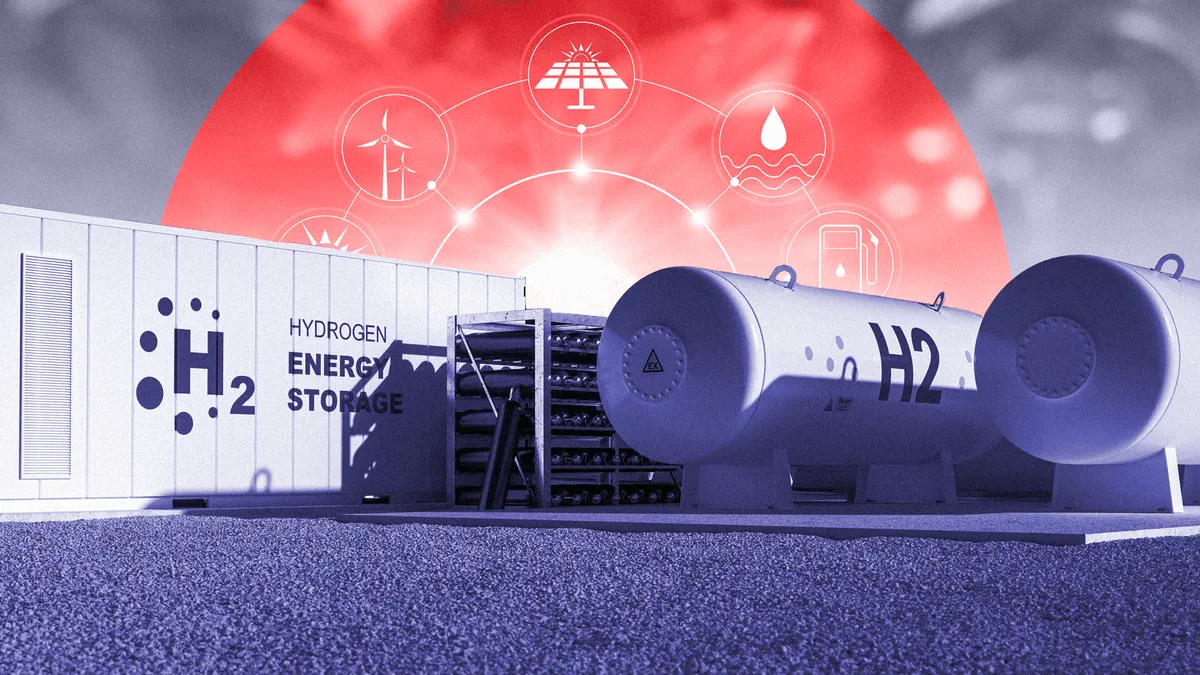Dive Brief:
- The New York Power Authority is gearing up to launch a green hydrogen demonstration project at its gas-fired power plant on Long Island.
- The project, slated to begin construction in the fall, will involve replacing up to 30% of the plant's gas-fired power with green hydrogen, which is created with renewable energy, in this case hydro power from Canada.
- New York's decision to begin testing the use of green hydrogen comes amid growing interest in the energy source globally, and could inspire other states to follow the Empire State's lead, said Janice Lin, founder and president of the Green Hydrogen Coalition (GHC).
Dive Insight:
New York Gov. Andrew Cuomo on Thursday announced the state would spend $8.5 million on the green hydrogen demonstration project at NYPA's Brentwood power plant on Long Island, which will help provide power at peak times for its combustion turbine. Installed in 2001, the turbine currently uses natural gas.
The move comes as New York ramps up efforts to decarbonize its power sector, with a goal of reducing emissions 85% below 1990 levels by 2050.
General Electric will build a "state-of-the art hydrogen/natural gas blending system," according to NYPA, while Fresh Meadow Power will install the system over the summer and provide "piping system design" and "material procurement" as well, according to NYPA. Airgas, a gas distribution company, will provide the green hydrogen, created with hydropower.
Starting in October, NYPA, with help from the Electric Power Research Institute, will "test different concentrations of hydrogen blended with natural gas at regular intervals," over a total of 10-15 hours over a six-to-eight week period, NYPA President and CEO Gil Quiniones said.
The demonstration project will be the first by a state utility to study the "feasibility of operating an existing power generation facility with a hydrogen and natural gas blend," according to NYPA.
"We are going to start at 5% and methodically and systemically increase it up to 30," Quiniones said.
As part of the demonstration project, the turbine at the Brentwood Power Station will be stopped periodically so the research team can look at various factors, including what happens to carbon emissions — and in particular, nitrous oxide — when you blend green hydrogen with natural gas, Quiniones said. The assessment team will also look at other key issues, such as safety, as well as whether there is any drop-off in the turbine's performance as green hydrogen is mixed in.
GHC's Lin said New York's demonstration project, and the involvement of the state's governor, will help encourage other states to also start exploring green hydrogen.
"That leadership is so important to making change happen," Lin said. "I am sure governors across the country are looking at this and saying 'wow,' maybe we should look at green hydrogen."
There are currently plans for a new green hydrogen plant in Ohio, Quiniones said.
But the focus of the New York project on retrofitting an existing plant is also important, with the potential, if successful, to roll out the technology at existing natural gas plants, as opposed to building specially designed generators, the NYPA chief said.
"There are a lot more existing power plants than brand new power plants," Quiniones said.
Still, there is considerable debate over whether green hydrogen technology is advanced enough to make a significant contribution to reducing carbon emissions and battling climate change.
GHC's Lin contends that green hydrogen is making big strides. There are plans for a green hydrogen power plant in Utah that will help supply power to Los Angeles, and there are a growing number of green hydrogen projects moving ahead in the United Kingdom, Europe and Saudi Arabia.
"Green hydrogen is the new oil," Lin said.
However, the Union of Concerned Scientists has argued against devoting resources to green hydrogen research, contending the supply of green hydrogen is too constrained for the foreseeable future. The focus should be on replacing gas with electrification, the group has argued.
Quiniones said he is aware of the criticism, but said that it would be a mistake to shut down research on a potentially valuable contributor to decarbonization.
"We are dealing with an existential threat, the climate crisis," he said. "I don't think it is the time to start eliminating potential technologies that might be part of the solution."
Meanwhile, the New York State Energy Research and Development Authority is moving ahead with efforts to boost research into renewable energy storage projects, an initiative that was also announced by Cuomo on Thursday alongside the green hydrogen demonstration project.
NYSERDA has set aside $12.5 million for demonstration projects and project development in the field of long-duration energy storage and is seeking proposals from researchers in "hydrogen, electric, chemical, mechanical, or thermal-electric storage technologies that will address cost, performance, and renewable integration challenges in New York State," according to a spokesperson for the authority.












